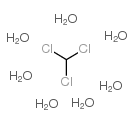10025-90-8
| 中文名 | 三氯化镨七水 |
|---|---|
| 英文名 | praseodymium(3+),trichloride,heptahydrate |
| 英文别名 |
PRASEODYMIUM CHLORIDE HEPTAHYDRATE
PRASEODYMIUM CHLORIDE HYDRATE praseodymiumchlorideheptahydrate99.9 PRASEODYMIUM CHLORIDE,HYDROUS |
| 密度 | 2.25 g/cm3 |
|---|---|
| 熔点 | 115ºC |
| 分子式 | CH15Cl3O7 |
| 分子量 | 245.48500 |
| 精确质量 | 243.98800 |
| PSA | 64.61000 |
| LogP | 1.53630 |
| 外观性状 | crystal | green |
| 储存条件 | 2-8°C密闭、阴凉干燥处 |
| 稳定性 | 易吸湿,溶解度334g/100g H2O(13℃)。180~200℃下在HCl气流中加热可以脱掉七个水。 |
| 水溶解性 | 334g/100mL H2O (13°C) [CRC10] |
| 分子结构 | 1、摩尔折射率:无可用的 2、摩尔体积(cm3/mol):无可用的 3、等张比容(90.2K):无可用的 4、表面张力(dyne/cm):无可用的 5、介电常数:无可用的 6、极化率(10-24cm3):无可用的 7、单一同位素质量:371.888111 Da 8、标称质量:372 Da 9、平均质量:373.3736 Da |
| 计算化学 | 1.疏水参数计算参考值(XlogP):无 2.氢键供体数量:7 3.氢键受体数量:10 4.可旋转化学键数量:0 5.互变异构体数量:无 6.拓扑分子极性表面积7 7.重原子数量:11 8.表面电荷:0 9.复杂度:0 10.同位素原子数量:0 11.确定原子立构中心数量:0 12.不确定原子立构中心数量:0 13.确定化学键立构中心数量:0 14.不确定化学键立构中心数量:0 15.共价键单元数量:11 |
| 更多 | 1. 性状:绿色晶体 2. 密度(g/mL,25℃):2.250 3. 相对蒸汽密度(g/mL,空气=1):未确定 4. 熔点(ºC): 115 5. 沸点(ºC,常压):未确定 6. 沸点(ºC,5.2kPa):未确定 7. 折射率:未确定 8. 闪点(ºC):未确定 9. 比旋光度(º):未确定 10. 自燃点或引燃温度(ºC):未确定 11. 蒸气压(kPa,20ºC):未确定 12. 饱和蒸气压(kPa,60ºC):未确定 13. 燃烧热(KJ/mol):未确定 14. 临界温度(ºC):未确定 15. 临界压力(KPa):未确定 16. 油水(辛醇/水)分配系数的对数值:未确定 17. 爆炸上限(%,V/V):未确定 18. 爆炸下限(%,V/V):未确定 19. 溶解性:未确定 |
|
Section 1: Product Identification Chemical Name:Praseodymium (III) chloride heptahydrate (99.9%-Pr) (REO) CAS Registry Number:10025-90-8 Formula:PrCl3.7H2O EINECS Number:233-794-4 Chemical Family:metal halide Synonym:Praseodymium trichloride, hexahydrate
Section 2: Composition and Information on Ingredients IngredientCAS NumberPercentACGIH (TWA)OSHA (PEL) Title Compound10025-90-8100%no datano data Section 3: Hazards Identification Emergency Overview:Irritating to skin and eyes. Inhalation can lead to irritation of the respiratory tract. Primary Routes of Exposure:Ingestion, inhalation Eye Contact:Causes mild irritation to the eyes. Skin Contact:Causes slight irritation of the skin. Inhalation:Inhalation of dust can lead to irritation of the respiratory tract. Ingestion:No information is available on the physiological effects of ingestion in humans Acute Health Affects:Irritating to skin and eyes. Chronic Health Affects:No information available on long-term chronic effects. NTP:No IARC:No OSHA:No SECTION 4: First Aid Measures Immediately flush the eyes with copious amounts of water for at least 10-15 minutes. A victim may need Eye Exposure: assistance in keeping their eye lids open. Get immediate medical attention. Wash the affected area with water. Remove contaminated clothes if necessary. Seek medical assistance if Skin Exposure: irritation persists. Remove the victim to fresh air. Closely monitor the victim for signs of respiratory problems, such as difficulty Inhalation: in breathing, coughing, wheezing, or pain. In such cases seek immediate medical assistance. Seek medical attention immediately. Keep the victim calm. Give the victim water (only if conscious). Induce Ingestion: vomiting only if directed by medical personnel. SECTION 5: Fire Fighting Measures Flash Point:not applicable Autoignition Temperature:none Explosion Limits:none Extinguishing Medium:Material is non-flammable. Special Fire Fighting Procedures:No special fire fighting procedures required. Hazardous Combustion andnone Decomposion Products: Unusual Fire or Explosion Hazards: No unusual fire or explosion hazards. SECTION 6: Accidental Release Measures Spill and Leak Procedures:Small spills can be mixed with vermiculite or sodium carbonate powder and swept up. SECTION 7: Handling and Storage Handling and Storage:Store material in a tightly sealed container. SECTION 8: Exposure Controls and Personal Protection Eye Protection:Always wear approved safety glasses when handling a chemical substance in the laboratory. Skin Protection:Wear appropriate chemical resistant gloves and protective clothing. Ventilation:Material may form a fine dust. If possible, handle the material in an efficient fume hood. If ventilation is not available, a respirator should be worn. The use of respirators requires a Respiratory Respirator: Protection Program to be in compliance with 29 CFR 1910.134. Ventilation:Material may form a fine dust. If possible, handle the material in an efficient fume hood. Additional Protection:No additional protection required. SECTION 9: Physical and Chemical Properties Color and Form:green xtl. Molecular Weight:247.27(373.38) Melting Point:115° Boiling Point:no data Vapor Pressure:no data Specific Gravity:2.25 Odor:none Solubility in Water: SECTION 10: Stability and Reactivity Stability:hygroscopic Hazardous Polymerization:no hazardous polymerization Conditions to Avoid:none Incompatibility:Active metals Decomposition Products:none SECTION 11: Toxicological Information RTECS Data:No information available in the RTECS files. Carcinogenic Effects:No data available Mutagenic Effects:No data available Tetratogenic Effects:No data available SECTION 12: Ecological Information Ecological Information:No information available SECTION 13: Disposal Considerations Disposal:Dispose of according to local, state and federal regulations. SECTION 14: Transportation Shipping Name (CFR):Non-hazardous Hazard Class (CFR):NA Additional Hazard Class (CFR):NA Packaging Group (CFR):NA UN ID Number (CFR):NA Shipping Name (IATA):Non-hazardous Hazard Class (IATA):NA Additional Hazard Class (IATA):NA Packaging Group (IATA):NA UN ID Number (IATA):NA SECTION 15: Regulatory Information TSCA:Not listed in the TSCA inventory SARA (Title 313):Title compound not listed. Second Ingredient:none SECTION 16 - ADDITIONAL INFORMATION N/A |
| 危害码 (欧洲) | Xi: Irritant; |
|---|---|
| 风险声明 (欧洲) | R36/37/38 |
| 安全声明 (欧洲) | 26-36-37/39 |
| RTECS号 | TU0175000 |
| 海关编码 | 28469025 |


